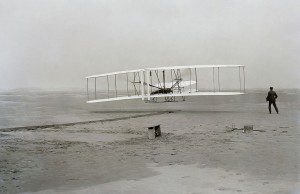On the 17th of December, in 1903, Orville Wright flew one hundred, twenty feet in his heavier than air flying machine. Later that day his brother Wilbur became the second to fly successfully, setting the next world record for controlled flight at eight hundred, fifty two feet.
Humans have dreamt of flying probably since there have been humans. The Hebrew scriptures describe Ezekiel’s flying chariot, the near east has its tales of flying carpets, and probably everyone in our culture knows the Greek story of Daedalus and Icarus.
Hot air balloons were the first successful way humans could fly. But, people wanted more control, and, again, pretty much everyone with a minimal access to western education is familiar with Leonardo da Vinci’s sketches of various kinds of possible flying machines. By the eighteenth century people were able to make working models. In the middle of the nineteenth century Sir George Cayley worked out most of the principals that would be needed to achieve heavier than air flight, and he built a very successful glider. Others including Francis Herbert Wienham, Alphonse Penaud, Alexander Mozhaiski and Matthew Piers Watt Boulton continued to advance the theoretical principals.
And people began to build. In 1890 Clement Ader made a brief, uncontrolled hop in his machine, and later claimed full flight. But he was unable to reproduce it with witnesses, and his claim has generally been rejected as a fraud. A more substantial claim to successful flight was made by Gustave Whitehead, who appears to have made a successful flight on the 14th of August, 1901 in Fairfield, Connecticut. There are no photographs, but the story was written up in the local newspaper. Whitehead didn’t keep a log or otherwise document his work. According to a Wikipedia article “Later analysis by aviation historians concluded that the design as a whole was flimsy and aerodynamically unsound.”
Samuel Pierpont Langley was the serious contender, designing a workable heavier than air flying machine. Short on funding, the clock ran out for him…
In the race to make the first uncontested (other than by the ubiquitous conspiracy buff community) “sustained, controlled, powered heavier-than-air manned flight” it happened as Wikipedia reports “at Kill Devil Hills, North Carolina, 4 miles (6.4 km) south of Kitty Hawk, North Carolina on 17 December 1903. The first flight by Orville Wright, of 120 feet (37 m) in 12 seconds, was recorded in a famous photograph. In the fourth flight of the same day, Wilbur Wright flew 852 feet (260 m) in 59 seconds.”
While this event is definitely markable as significant, it would actually continue to be a race to the first practical aircraft.
But, today, we get to pause for that second or two, and think, the dream was not only achievable, people did it.
Humans could fly.
And the world would never be the same…













